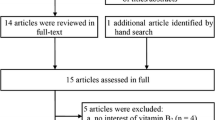Previous data on animals and humans suggest that vitamin E may be a protective factor against cancer. A low dietary vitamin E intake has been suggested to increase the risk of breast cancer. We examined the dietary intake and the concentration of vitamin E in breast adipose tissue of women in Kuopio, Finland, diagnosed between 1990 and 1992 with benign breast disease (n=34) and with breast cancer (n=32). In postmenopausal women, lower dietary intake (P=0.006) and a smaller concentration of vitamin E in breast adipose tissue (P=0.024) were observed in breast cancer patients than in subjects with benign breast disease. Partial correlation showed that the vitamin E concentration in the breast adipose tissue correlated positively with the dietary intake of vitamin E (r=0.25, P=0.023), indicating that the vitamin E concentration in breast adipose tissue reflects the dietary intake of vitamin E.
Similar content being viewed by others
References
Haber, SL, Wissler, RW. Effect of vitamin E on the carcinogenicity of methylcholanthrene. Proc Soc Exp Biol Med 1962; 111: 774–5.
Harmon, D. Dimethyl benzanthracene-induced cancer inhibiting effect of dietary vitamin E. Clin Res 1969; 17: 125.
Cook, MG, McNamara, P. Effect of dietary vitamin E on dimethyl benzanthracene-induced colonic tumors in mice. Cancer Res 1980; 40: 1329–31.
Wattenberg, LW. Inhibition of carcinogenic and toxic effects of polycyclic hydrocarbons by phenolic antioxidants and ethoxyquin. JNCI 1972; 48: 1425–30.
Ip, C. Dietary vitamin E intake and mammary carcinogenesis in rats. Carcinogenesis 1982; 3: 1453–6.
Horvath, PM, Ip, C. Synergistic effect of vitamin E and selenium in the chemoprevention of mammary carcinogenesis in rats. Cancer Res 1983; 43: 5335–41.
Wald, NJ, Boreham, J, Hayward, JL, et al. Plasma retinol, β-carotene and vitamin E levels in relation to the future risk of breast cancer. Br J Cancer 1984; 49: 321–4.
Graham, S, Hellman, R, Marshall, J, et al. Nutritional epidemiology of postmenopausal breast cancer in western New York. Am J Epidemiol 1991; 134: 552–66.
Kumar, K, Thangaraju, M, Sachdanaandam, P. Changes observed in antioxidant system in the blood of postmenopausal women with breast cancer. Biochem Int 1991; 25(2): 371–80.
Rohan, TE, Howe, GR, Friedenreich, CM, et al. Dietary fiber, vitamin A, C, and E, and risk of breast cancer: a cohort study. Cancer Causes Control 1993; 4: 29–37.
Yuan, JM, Wang, QS, Ross, RK, et al. Diet and breast cancer in Shanghai and Tianjin, China. Br J Cancer 1995; 71(6): 1353–8.
Kardinaal, AF, van 't veer, P, Brant, HA, et al. Relations between antioxidant vitamins in adipose tissue, plasma, and diet. Am J Epidemiol 1995; 141(5): 440–50.
Parker, RS. Carotenoid and tocopherol composition of human adipose tissue. Am J Clin Nutr 1988; 47: 33–6.
Rautalahti, M, Albanes, D, Hyvönen, L, et al. Effect of sampling site on retinol, carotenoid, tocopherol, and tocotrienol concentration of adipose tissue of human breast with cancer. Ann Nutr Metab 1990; 34: 37–41.
International Union Against Cancer. TNM: Classification of Malignant Tumours. Fourth, fully revised edition. Berlin, Germany: IUCN, 1987.
Männistö, S, Virtanen, M, Mikkonen, T, Pietinen, P. Reproducibility and validity of a food frequency questionnaire in a case-control study on breast cancer. J Clin Epidemiol 1996; 49: 401–9.
Pikkarainen, SA, Parviainen, MT. Determination of retinyl palmitate and total vitamin A content in liver and liver-based ready-to-eat foods. J Chromatography 1992; 577: 163–6.
London, SJ, Stein, EA, Henderson, IC. Carotenoids, retinol, and vitamin E and risk of proliferative benign breast disease and breast cancer. Cancer Causes Control 1992; 3: 503–12.
Knekt, P. Serum vitamin E level and risk of female cancers. Int J Epidemiol 1988; 17: 281–6.
Buzina, R, Jusic, M, Brodarec, A, et al. The assessment of dietary vitamin intake of 24 Istrian farmers. II. Comparison between the dietary intake and biochemical status of ascorbic acid, vitamin A, thiamine, riboflavin and niacin. Int J Vitamin Nutr Res 1971; 41: 289–300.
Willett, WC, Stampfer, MJ, Underwood, BA, et al. Vitamin A, E, and carotene: effects of supplementation on their plasma levels. Am J Clin Nutr 1983; 38: 559–66.
Schafer, L, Overvad, K. Subcutaneous adipose tissue fatty acids and vitamin E in humans: relation to diet and sampling site. Am J Clin Nutr 1990; 52: 486–90.
Dorgan, JF, Schatzkin, A. Antioxidant micronutrients in cancer prevention. Oncol Clin North Am 1991; 5: 43–68.
Boutwell, RK. The function and mechanism of promoters of carcinogenesis. CRC Crit Rev Toxicol 1974; 2: 419–43.
Wouterson RA, van Gardern-Hoetmer A: Inhibition of dietary fat-promoted development of pre-neoplastic lesions in exocrine pancreas of rats and hamsters by supplememental A, C and E. Cancer Lett 1988; 179–89.
Parker, P. Protective role of vitamin E in biological systtems. Am J Clin Nutr 1991; 53: 1050S-5S.
Prasad, KN, Edwards-Prasad, J. Vitamin E and cancer prevention: recent advances and future potential. J Am Coll Nutr 1992; 11: 487–500.
Ip, C. Vitamin E potentates the prophylactic effect of selenium in chemically induce mammary tumorigenesis. Proc Am Assoc Cancer Res 1982; 23: 70.
Additional information
Drs Zhu and Uusitupa are with the Department of Clinical Nutrition, University of Kuopio, Finland, Dr Parviainen is with the Laboratory of Helsinki University, Central Hospital, Helsinki, Finland. Drs Männistö and Pietinen are with the Department of Nutrition, National Public Health Institute, Helsinki, Finland Dr Eskelinen is with the Department of Surgery, and Dr Syrjänen is with the Department of Pathology, University of Kuopio. Address correspondence to Professor Uusitupa, Department of Clinical Nutrition, University of Kuopio, P.O. Box 1627, FIN-70211 Kuopio, Finland. This study was supported by research grants from the Finnish Cancer Society, and by EVO funding for the Breast Cancer Project of Kuopio Cancer Research Center from the Kuopio University Hospital, Finland.
Rights and permissions
About this article
Cite this article
Zhu, Z., Parviainen, M., Männistö, S. et al. Vitamin E concentration in breast adipose tissue of breast cancer patients (Kuopio, Finland). Cancer Causes Control 7, 591–595 (1996). https://doi.org/10.1007/BF00051701
Received:
Accepted:
Issue Date:
DOI: https://doi.org/10.1007/BF00051701




